Saturday, March 13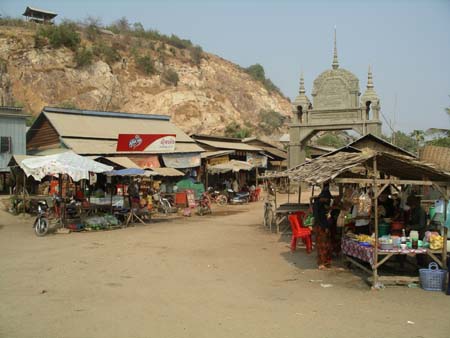
Paula and Steve: Today was a day for us to explore and learn more about life here in Cambodia. We intentionally had no temples on the itinerary - this was simply an opportunity to see how Cambodians live and work. As is normally the case, days like this become great learning experiences, this one also brought a little adventure that we'll always remember.
We began the morning with a trip to the Tonle Sap Lake, located 20 kilometers
south of Siem Reap. "Tonle" means lake, and "Sap" means
fresh water - this lake is the largest fresh water lake in 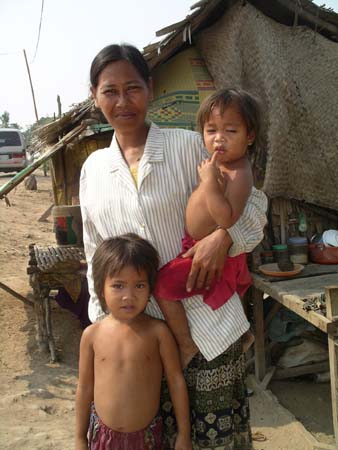 Southeast
Asia and is an important source of fish for Cambodians. When Thy told us it
would take one hour to make the 13-mile drive, we knew we were going to see
the real Cambodia!
Southeast
Asia and is an important source of fish for Cambodians. When Thy told us it
would take one hour to make the 13-mile drive, we knew we were going to see
the real Cambodia!
Today was another sweltering day. It seems to become hotter and more humid
each day, and we can't remember ever feeling air this thick. The temperature
today was certainly over 100, and combined with the humidity made things very
uncomfortable. Thy told us that this isn't nearly the worst of it - April
and May are by far the hottest months of the year before things cool down
during the rainy season in June and July.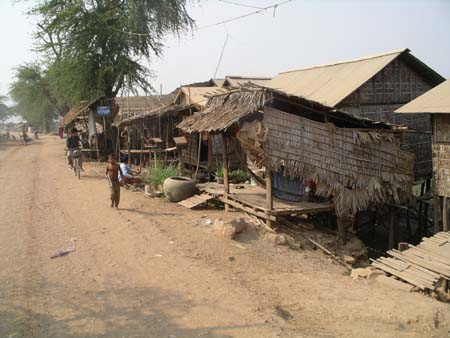 Wow.
Wow.
Tonle Sap measures 150 kilometers by 45 kilometers and is fed by a tributary of the Mekong River. Amazingly, during the annual rainy season there is so much water flowing down the Mekong that it backs up at the delta and actually reverses directions (we learned that this is the only major river in the world where this happens)! There is simply not enough capacity for the delta flowing into the South China Sea to handle all the water from the Mekong. Instead, much of the water flows back up the tributary leading to the Tonle Sap, filling it to a level that is four times higher than it is during the dry season. Interestingly, it is this reverse-flow that helped the Khmer Empire transport the rocks used for its temples to the Angkor area back in the 12th century - many of these were floated "up" the river.
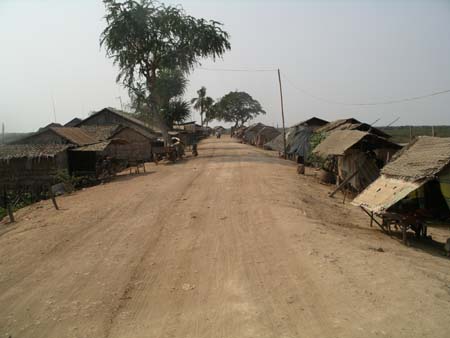 During
the 12th century, a man-made canal was built between Siem Reap and the lake,
and the road we took today hugged this canal. The paved part of the road ended
abruptly shortly into our trip, and a jarring dirt "road" took us
the rest of the way. The canal and lake support the thousands of fishermen
that live here with their families, and it was obvious that travel is very
difficult.
During
the 12th century, a man-made canal was built between Siem Reap and the lake,
and the road we took today hugged this canal. The paved part of the road ended
abruptly shortly into our trip, and a jarring dirt "road" took us
the rest of the way. The canal and lake support the thousands of fishermen
that live here with their families, and it was obvious that travel is very
difficult.
Much of our drive went through fishing villages located in an area that saw intense fighting between government forces and the Khmer Rouge in the 1970's. At one point, these villages were burned to the ground by the Khmer Rouge, and we climbed a small hill that was used by the government for defensive purposes against the Khmer Rouge.
As our mini-van struggled through the rutted road (at speeds that never exceeded
10 mph), it was easy to see the poverty and 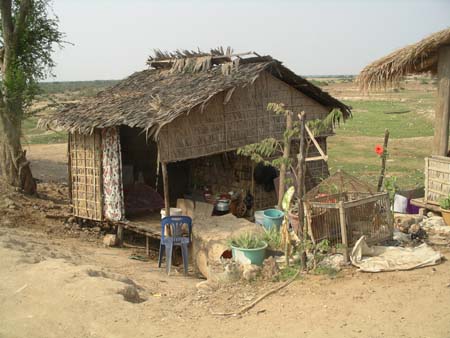 difficult
living conditions that the people here endure every day. The road is lined
with small, fragile homes built on stilts with bamboo and palm leaves. During
the rainy season, water fills the entire area and many of the homes must be
raised even higher than current levels to prevent flo
difficult
living conditions that the people here endure every day. The road is lined
with small, fragile homes built on stilts with bamboo and palm leaves. During
the rainy season, water fills the entire area and many of the homes must be
raised even higher than current levels to prevent flo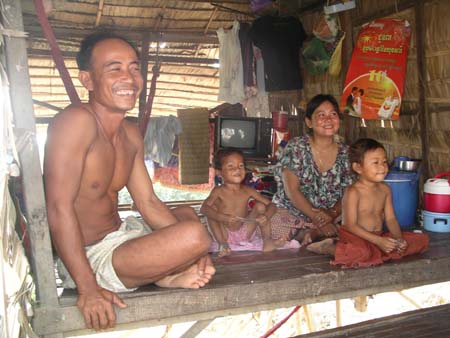 oding.
We're now in the dry season, and at this point the lake was nowhere to be
seen. Thy told us that in the rainy season the lake is 8-10 meters deep but
during the dry season there are only 2-3 meters of water. As we would find
out later, this was a clue to the adventure ahead..
oding.
We're now in the dry season, and at this point the lake was nowhere to be
seen. Thy told us that in the rainy season the lake is 8-10 meters deep but
during the dry season there are only 2-3 meters of water. As we would find
out later, this was a clue to the adventure ahead..
As we always love to do, we stopped the car to walk along the road and speak
with some of the people who live here. These villagers are all 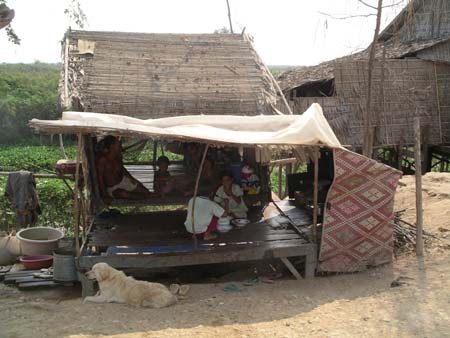 fishermen,
and from what we saw today are among the poorest people that we have encountered
anywhere during our travels. Our first stop was with a family of seven whose
single-room living space was probably no more than 10 feet by 15 feet. When
we visited they were sharing a meal of rice and fish from their kitchen which
consisted of a small fire pit, a few pots and bowls, and a small cooler with
ice for refrigeration. Their single room has two hammocks strung from bamboo
poles where the parents sleep, providing space under and around them for the
children to sleep on the floor. There is a small TV in one corner and a well
in the back for water and bathing. This represented all the possessions for
this couple
fishermen,
and from what we saw today are among the poorest people that we have encountered
anywhere during our travels. Our first stop was with a family of seven whose
single-room living space was probably no more than 10 feet by 15 feet. When
we visited they were sharing a meal of rice and fish from their kitchen which
consisted of a small fire pit, a few pots and bowls, and a small cooler with
ice for refrigeration. Their single room has two hammocks strung from bamboo
poles where the parents sleep, providing space under and around them for the
children to sleep on the floor. There is a small TV in one corner and a well
in the back for water and bathing. This represented all the possessions for
this couple 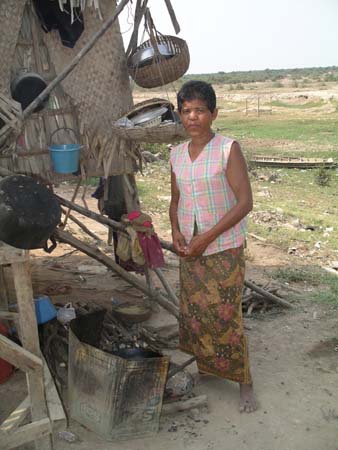 and
their 5 young children.
and
their 5 young children.
The father told us that that this year has not been a good one for fishing.
He indicated that many of the fish in the lake were being caught using a method
of electrocution which not only kills the fish but also damages the breeding
grounds. The government is apparently not providing much support to end this
practice. During normal times, fish are very plentiful (the Tonle Sap Lake
is the largest source of freshwater fish anywhere in Asia), and prices are
very low - usually 30 cents per pound. The fish caught here are made into
fish paste, dried, smoked or exported fresh to Thailand. Since Cambodia has
still not established many trade agreements, it often exports products to
Thailand which then sells to other countries. 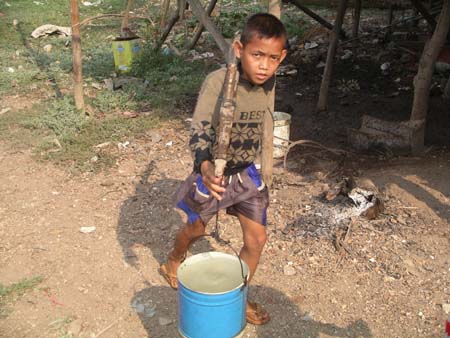
We also spoke with a woman cooking fish in her kitchen outside her home and
saw several children fetching water from a deep well. We were surprised when
the children told us they were 14 and 11 years old. We thought by their size
and features that they were not more than 8 or 9. Thy told us that malnutrition
continues to be a major problem in many parts of Cambodia, and that most children
are very small. We also stopped to donate shampoos and soaps from our hotel
to a 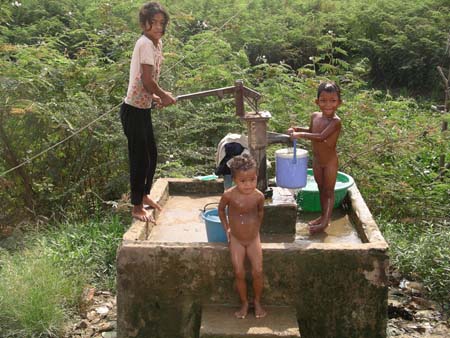 group
of children from the village. It was sad to see them all clamoring around
Thy as he handed out these small gifts, especially when there were no more
to give…
group
of children from the village. It was sad to see them all clamoring around
Thy as he handed out these small gifts, especially when there were no more
to give…
As we continued down the road, we saw several young men throwing simple nets
into the river in hopes of catching some small fish. We saw boys using their
sling shots to shoot at birds, not for fun but in an attempt to bring food
home for dinner. We watched as small children bathed naked in the streets.
Older women simply sat in their homes staring aimlessly as we 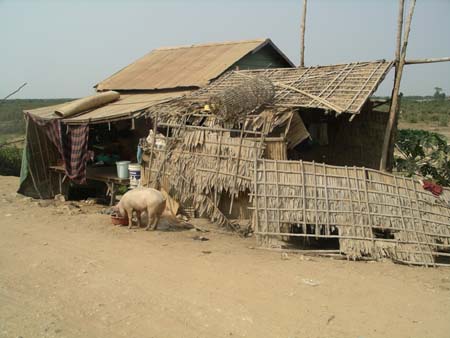 passed
by. Each time we returned to our air-conditioned van and its stock of ice-cold
water, we were reminded that for these people there's no escape from the heat.
Life here is obviously very difficult, and Thy told us that what we saw today
represents typical living conditions for probably 80% of Cambodia's population.
It was difficult to see.
passed
by. Each time we returned to our air-conditioned van and its stock of ice-cold
water, we were reminded that for these people there's no escape from the heat.
Life here is obviously very difficult, and Thy told us that what we saw today
represents typical living conditions for probably 80% of Cambodia's population.
It was difficult to see.
At one point we passed through some beautiful fields of lotus flowers being grown by the people here. These are important both in the Hindu nd Buddhist religions, and most of the flowers here are sold to Buddhist monasteries.
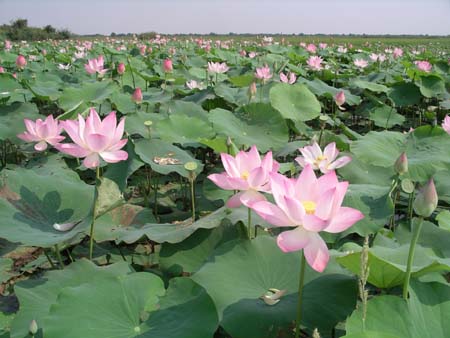
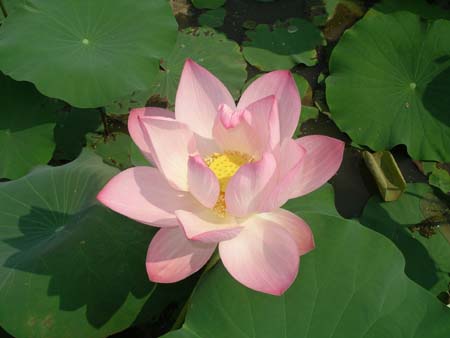
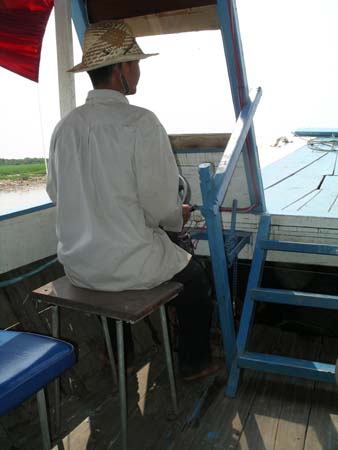
We finally reached the lake and boarded our boat to explore one of the lake's 5 "floating villages." As we began our journey through a muddy canal that leads to the lake, we suspected that we were in for an adventure. The fact that the captain was unsuccessful in getting his boat into reverse (instead his son was sent to the bow with a long pole to push the boat back) and seemed to be struggling to even turn the wheel (which looked to be a steering wheel from an old Toyota) certainly did not inspire confidence…
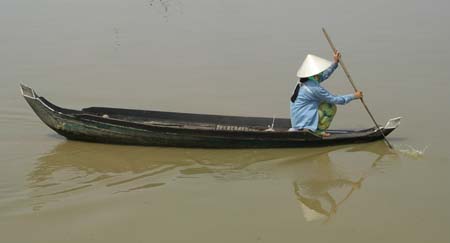 Somehow,
the captain did manage to get the steering working well enough to guide us
onto the lake. Things seemed fine until we noticed the boat struggling to
move ahead. The engine was revving, but we were slowing down! Soon it was
clear that we were dragging on the bottom of the very shallow waters, and
it didn't take long for us to become totally stuck. The captain and his young
son jumped into action, leaving the boat to try to push us out. After much
heaving and grunting, we inched a bit forward and the captain then made multiple
efforts to gun the unbelievably loud engine and force us through. Mud was
flying in all directions out from behind the propeller, the noise was deafening,
and we began to smell the heat from the burning fuel. The captain finally
turned off the engine when he realized that no water was making it through
th
Somehow,
the captain did manage to get the steering working well enough to guide us
onto the lake. Things seemed fine until we noticed the boat struggling to
move ahead. The engine was revving, but we were slowing down! Soon it was
clear that we were dragging on the bottom of the very shallow waters, and
it didn't take long for us to become totally stuck. The captain and his young
son jumped into action, leaving the boat to try to push us out. After much
heaving and grunting, we inched a bit forward and the captain then made multiple
efforts to gun the unbelievably loud engine and force us through. Mud was
flying in all directions out from behind the propeller, the noise was deafening,
and we began to smell the heat from the burning fuel. The captain finally
turned off the engine when he realized that no water was making it through
th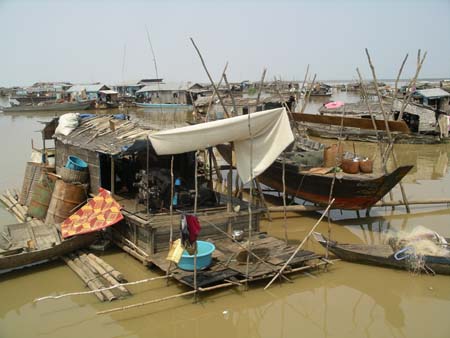 e
cooling system. He then pulled out a rusty wrench, and went to work. We were
sure our boat trip was over.
e
cooling system. He then pulled out a rusty wrench, and went to work. We were
sure our boat trip was over.
This whole cycle of pushing, revving and engine repair was actually repeated 3 or 4 times. We had to laugh as other boats steamed by, their passengers smiling and pointing at us. Finally, amazingly, we made it out and were on our way out to the lake. The real question was whether we'd be able to return through this area on our way back…
Tonle Sap Lake has 5 floating villages, and the one we visited today is home
to 2,000 people who live their entire lives here. We saw floating homes of
all shapes and sizes, schools, stores, churches and fish farms. We watched
as small children left school on boats that they paddled themselves. We saw
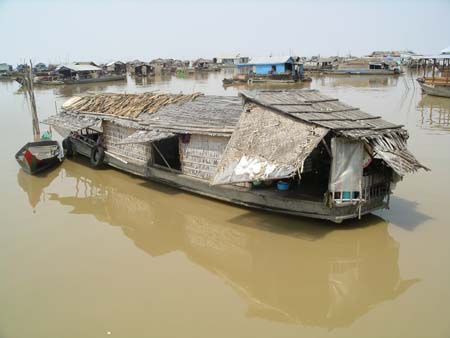 merchants
selling food door-to-door on boats. Dogs hung out on floating porches. What
an amazing sight! We had seen much smaller villages of this type in Vietnam's
Halong Bay, but nothing of this scale. It's just amazing to think about the
differences between our lives and the lives of these people.
merchants
selling food door-to-door on boats. Dogs hung out on floating porches. What
an amazing sight! We had seen much smaller villages of this type in Vietnam's
Halong Bay, but nothing of this scale. It's just amazing to think about the
differences between our lives and the lives of these people.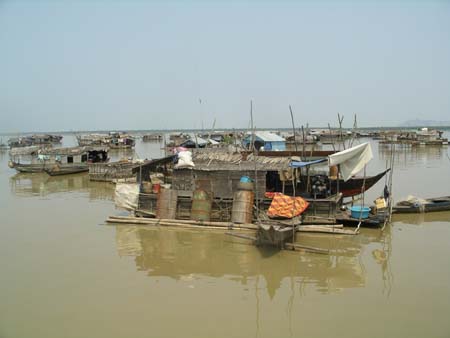
After exploring the floating village and stopping for a drink at a fish/crocodile
farm that doubles as restaurant and store, we made our way back to "port."
The captain took things at full speed, evidently determined to push his way
through the shallow mud. No luck! We 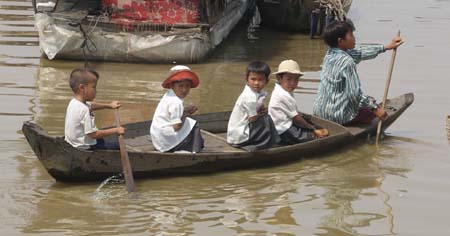 became
stuck again, this time for good. The multiple attempts at pushing and engine
revving did not work (the picture below shows the captain and his son and
their futile efforts), and soon another boat was on its way to rescue us (we
assume they must have seen our struggles from shore, because there are no
radios on board). We boarded the second boat, very ready at this point to
be back on land.
became
stuck again, this time for good. The multiple attempts at pushing and engine
revving did not work (the picture below shows the captain and his son and
their futile efforts), and soon another boat was on its way to rescue us (we
assume they must have seen our struggles from shore, because there are no
radios on board). We boarded the second boat, very ready at this point to
be back on land. 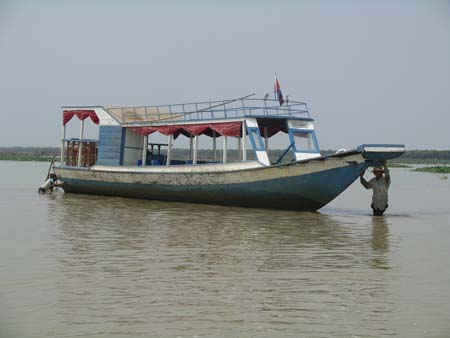 Somehow,
despite its relative ease in reaching us, the new boat also now became stuck!
Was it our weight? Anyway, we had to all laugh as the process totally repeated
itself, this time with two young boys who served as our "captains."
Finally, they successfully got us through the mud and back to shore. What
fun!
Somehow,
despite its relative ease in reaching us, the new boat also now became stuck!
Was it our weight? Anyway, we had to all laugh as the process totally repeated
itself, this time with two young boys who served as our "captains."
Finally, they successfully got us through the mud and back to shore. What
fun!
We took our standard afternoon break, swim and nap (the heat takes so much
out of us), and then headed out for three last things we 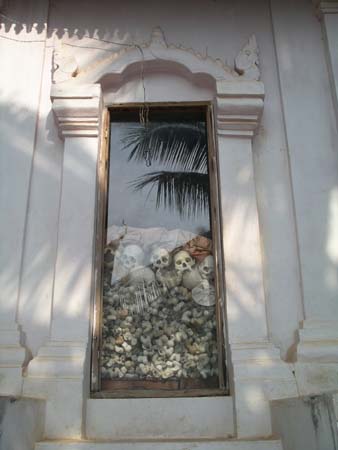 wanted
to see before leaving Siem Reap. First we stopped at a memorial for the victims
of Pol Pot's Khmer Rouge regime. From 1975 through 1979, three million Cambodians
were murdered by Pol Pot, many here in Siem Reap. Some of the bones have been
gathered and displayed in a memorial located near our hotel. There's also
a plaque honoring the
wanted
to see before leaving Siem Reap. First we stopped at a memorial for the victims
of Pol Pot's Khmer Rouge regime. From 1975 through 1979, three million Cambodians
were murdered by Pol Pot, many here in Siem Reap. Some of the bones have been
gathered and displayed in a memorial located near our hotel. There's also
a plaque honoring the 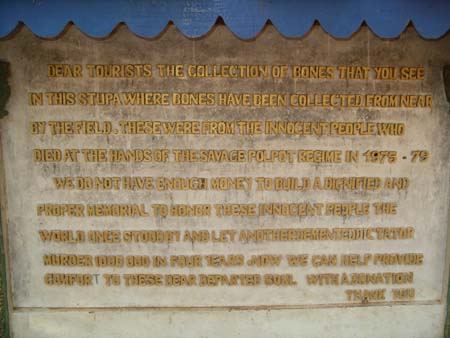 victims.
We listened as Thy told us some of the terrible stories from these days. There
is no one here whose life hasn't been impacted by some way by what happened.
As an example, Thy told us that our driver lost both his parents during this
period, and is an only child with no surviving family. We also learned that
because Thy grew up during the Khmer Rouge and Vietnam occupations he was
not able to attend school until he was 12 years old. Despite this, he has
worked extremely hard and recently graduated from a local university.
victims.
We listened as Thy told us some of the terrible stories from these days. There
is no one here whose life hasn't been impacted by some way by what happened.
As an example, Thy told us that our driver lost both his parents during this
period, and is an only child with no surviving family. We also learned that
because Thy grew up during the Khmer Rouge and Vietnam occupations he was
not able to attend school until he was 12 years old. Despite this, he has
worked extremely hard and recently graduated from a local university.
Next was a trip to the Siem Reap provincial hospital. Although there are several private hospitals and clinics in Siem Reap, we decided to visit the public hospital here to get a realistic picture of health care for the majority of residents. As we pulled in, the only thing that resembled our hospitals in the U.S. was a relatively modern-looking ambulance. We soon discovered that this ambulance was probably the only luxury in the system.
We were initially greeted by a young doctor with a warm, friendly smile.
He was interested in showing us around but first had us meet with the hospital's
administrator for approval. The administrator was an older austere gentleman
who questioned our intent but somewhat grudgingly allowed us to proceed.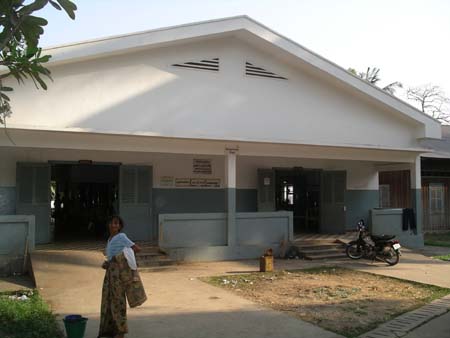
The doctor, the hospital's general surgeon, walked us around the grounds
of the hospital showing us the 6-7 buildings which housed various wards and
facilities. There is a laboratory, operating area, emergency room (pictured
here on the left), x-ray and large wards devoted to general surgery, gynecology,
general medical and tuberculosis units. The units are large, often with 20
beds all lined up. There are no curtains between the beds, and no linens.
Other than a few IV units, no medical equipment at all was visible. People
were lying or sitting on the mattresses attended by family members. The emergency
room is essentially a large open room with beds, and resembles a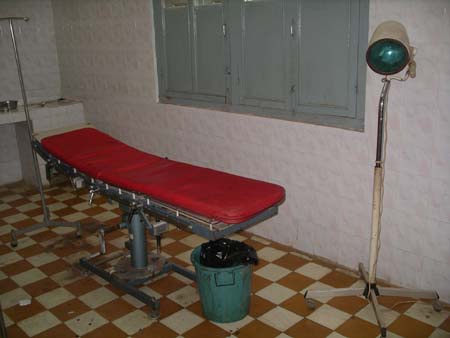 college dormitory more than a health care facility
college dormitory more than a health care facility
Other than the doctor escorting us, we did not see any other medical personnel. Family members were also preparing food for patients in the courtyard. The doctor explained that they don't have enough supplies, medicines, equipment or staff. He was particularly concerned with the lack sterile supplies. He also told us that the conditions they treat most frequently include tuberculosis, malaria, hypertension, diabetes and AIDS.
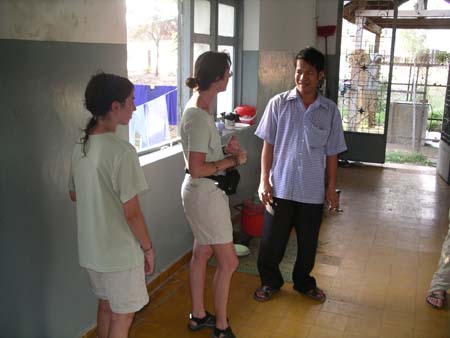 The
emergency room was treating three victims of motorcycle accidents and the
doctor confirmed that this is a common problem. He told us that he wanted
to specialize in neurology because he sees so many people with head injuries.
At one point, we entered an examination room which had a desk, bed and scale.
There was no other equipment or supplies. Surprisingly, we
The
emergency room was treating three victims of motorcycle accidents and the
doctor confirmed that this is a common problem. He told us that he wanted
to specialize in neurology because he sees so many people with head injuries.
At one point, we entered an examination room which had a desk, bed and scale.
There was no other equipment or supplies. Surprisingly, we 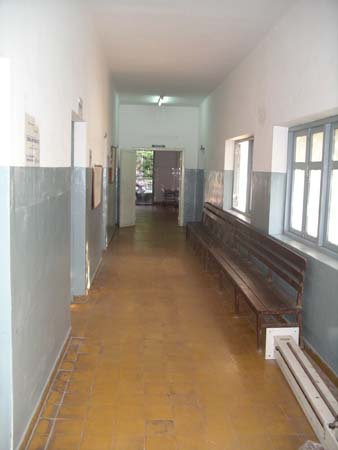 saw
a sign in English on the wall explaining the costs of various services for
tourists. The cost for a consultation was just $10, an x-ray was also $10
and hospitalization $30/day. There is a separate building for tourists - it
looked deserted but was brand new. He explained that the local people can
receive as much care as they need in the facility for 30,000 riels (about
$7). If they cannot afford the fee, care is provided free. When we asked what
happens when someone needs for specialized care, he indicated that they are
transported to Phnom Penh. Unfortunately, this drive takes 5-7 hours depending
on the road conditions.
saw
a sign in English on the wall explaining the costs of various services for
tourists. The cost for a consultation was just $10, an x-ray was also $10
and hospitalization $30/day. There is a separate building for tourists - it
looked deserted but was brand new. He explained that the local people can
receive as much care as they need in the facility for 30,000 riels (about
$7). If they cannot afford the fee, care is provided free. When we asked what
happens when someone needs for specialized care, he indicated that they are
transported to Phnom Penh. Unfortunately, this drive takes 5-7 hours depending
on the road conditions.
We have visited many homes and schools on our trip but this was our first opportunity to see healthcare in a developing country. It certainly gave us an appreciation for why mortality and morbidity rates continue to be so high here. It was very difficult to see the glaring need for basic equipment and supplies.
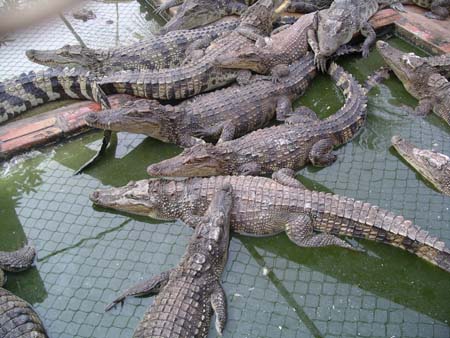 Finally,
we had asked Thy to take us to his home so that we could see how he and his
family raise crocodiles. This has become a very common side-business for many
Siem Reap residents, and for good reason. For those who can afford the land
to house the crocodiles, this is a very good business. Thy has just purchased
36 juvenile crocodiles (about 1 year in age) for $35 each. Today, crocodiles
that are 5-6
Finally,
we had asked Thy to take us to his home so that we could see how he and his
family raise crocodiles. This has become a very common side-business for many
Siem Reap residents, and for good reason. For those who can afford the land
to house the crocodiles, this is a very good business. Thy has just purchased
36 juvenile crocodiles (about 1 year in age) for $35 each. Today, crocodiles
that are 5-6 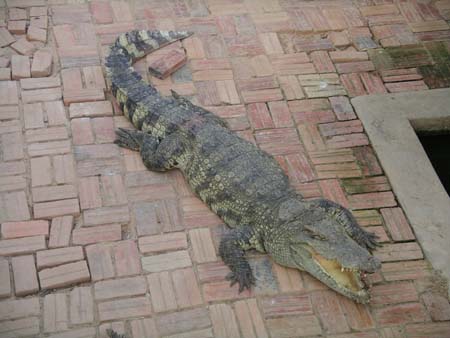 years
old are sold live to China for $2,000 apiece! By our calculations, that's
a pretty good return on investment.
years
old are sold live to China for $2,000 apiece! By our calculations, that's
a pretty good return on investment.
Thy and his family have several pens where the crocodiles are hatched and raised, and it was interesting to see crocs of all ages. Those that were full-grown were particularly impressive, especially as they sat with their mouths open (they do this to help keep themselves cool).
Tomorrow we'll leave Cambodia and fly back to Bangkok for a 1-day layover before our flight on Monday to Beijing, China. Our experience here has been a great one, and we leave with many strong memories.
